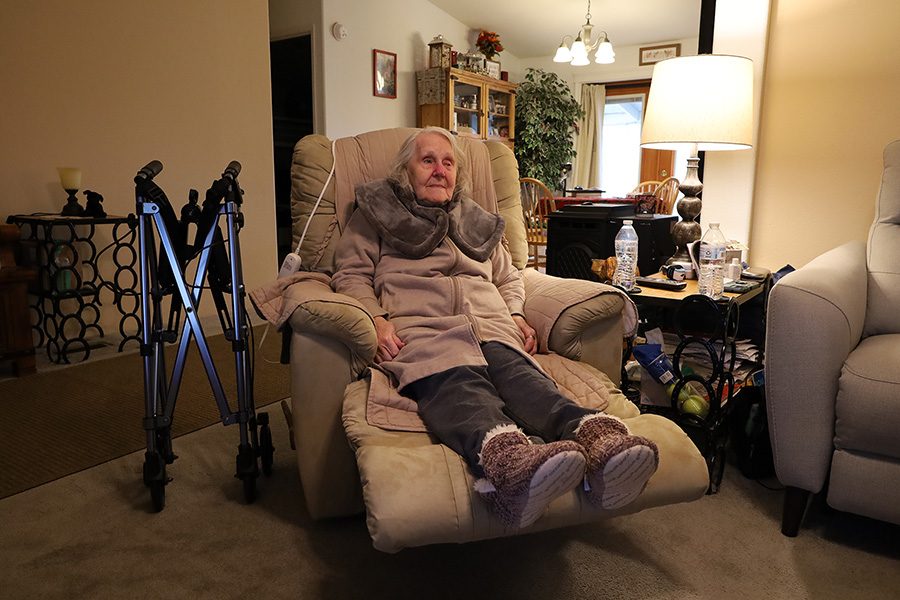
Home » This year marks 25th anniversary of key government reimbursement program
EEOICPA
This year marks 25th anniversary of key government reimbursement program

Dorothy Ogden, 87, of West Richland, and two of her family members are all white card holders after retiring from long careers at Hanford. They have said the process of getting reimbursement through the Energy Employees Occupational Illness Compensation Program Act has been a difficult one.
Photo by Rachel VisickApril 14, 2025
Caring for patients with Hanford-related illnesses is rewarding work for the doctors at Richland’s Complex Care Center.
Prioritizing the health and well-being of those who’ve worked in potentially dangerous environments, such as the Hanford nuclear site, is an honor, said Dr. Jeffrey Allgaier, chief medical officer and one of two providers at the senior-focused center.
“Just like it’s important we take care of our veterans, it’s important that we also do a good job of taking care of these folks who spent … a lot of their lifetime working out on the Hanford site, folks who’ve done a lot for us as a community, so we think it’s the right thing to do,” Allgaier said.
His clinic provides primary care and urgent care with an emphasis on helping patients manage chronic conditions. Patients who became ill while working at U.S. Department of Energy sites often have difficult medical problems due to their exposure to harmful substances.
Complex Care Center is one of several medical providers around the Tri-Cities that support the Energy Employees Occupational Illness Compensation Program Act, or EEOICPA.
This year marks the 25th anniversary of the program, which is intended to compensate DOE employees who became ill after being exposed to harmful substances while working at certain sites, including Hanford and Pacific Northwest National Laboratory.
But EEOICPA can be a challenging program to navigate.
Qualifying for the program’s so-called “white card” to obtain health services won’t make medical expenses disappear. It can be difficult to obtain and not all providers will accept it. Reimbursements may take a long time and can mean a heavy lift in terms of paperwork that’s tough to understand without support.
One West Richland family said it’s time for EEOICPA to evolve after 25 years to better support those who still rely on it: “It’s not fair to the future generation or the past generation that it’s not a streamlined process.”
Hanford illnesses
For many years, the Hanford site produced plutonium for the United States, powering nuclear weapons – and generating tons of waste.
Workers who were exposed to dangerous substances at Hanford can receive a “white card,” which can provide compensation for medical treatment related to their approved condition.
While the program applies to scores of sites across the country, the impact of the Hanford site is immense in the Tri-Cities. Both Hanford and PNNL are among the top 20 facilities where the most benefits have been paid under the program.
To date, 23,825 EEOICPA cases from 13,546 workers have been filed for the Hanford site alone. A little less than half of the cases, 11,227, have seen $2.5 billion in compensation and medical bills paid.
Program benefits
Workers can apply for EEOICPA under two different sections: Part B and Part E. Part B covers those who have a radiogenic cancer, chronic beryllium disease, beryllium sensitivity or chronic silicosis resulting from their exposure, and workers whose applications are accepted receive a lump sum payment of $150,000 in addition to payment of medical expenses going forward.
Part E can provide benefits, including variable compensation up to $250,000, for “any illness if it can be determined that it was ‘at least as likely as not’ that occupational exposure to a toxic substance was a significant factor in causing, contributing to or aggravating the illness or death of an employee,” according to the U.S. Department of Labor, which administers the program.
EEOICPA can compensate survivors of DOE employees, provide reimbursement for home health care and medical treatment.
Reimbursements can cover travel to see specialists, durable medical equipment like wheelchairs or a hospital bed, or a necessary bathroom remodel, said Kyli Placke, director of clinical services and co-owner of Hanford Home Health, along with Administrator Charmine Faulkner.
Over time, new qualifying exposures and diseases are added, Placke and Faulkner said, making it worth it to reapply even if a worker was denied at one time.
Hanford Home Health is one of several home health care facilities around the Tri-Cities that accepts the white card and helps treat DOE workers. It also can help people apply for the white card free of charge, but at times the home health company may need to refer applicants to paid resources.
Resources like the Hanford Resource Center in Richland, administered by the Department of Labor, and the Hanford Workforce Engagement Center – a collaboration between the Department of Energy, Hanford site contractors, the Hanford Atomic Metal Trades Council and the Central Washington Building and Trades Council – also can help with white card applications.
The fate of the Hanford Resource Center, one of 11 such DOL facilities across the country, is unknown. It was listed as one of the federal leases canceled by the Department of Government Efficiency, expected to save $53,733. It’s not clear how services may be impacted or if there are plans to relocate.
“I know under the federal law that the resource centers are part of the federal law and that they’ll be in communities with higher numbers of DOE employees, and so I would think it would take a pretty big act of Congress to rewrite that federal law,” said Tiki Davis, benefits advisor with Richland’s United Energy Workers Healthcare, which offers home health care as well as information about EEOICPA and how its benefits work.

For the doctors at Complex Care Center in Richland, caring for patients with Hanford-related illnesses is rewarding work. Above, Dr. Jeffrey Allgaier, chief medical officer, poses with a patient.
| Courtesy Complex Care CenterChallenges
While free resources are available to help applicants with their white card application, there are also companies that require payment for their assistance. If the application is denied, then they can’t charge anything for the service, Davis said.
If the application is accepted, they can charge up to 2% of the award granted, or up to 10% if the application was previously denied, she said.
It can be difficult to sort through the various entities seeking to help qualifying workers, understand the resources available and to know which are free or paid.
Navigating the system
Going through the application process solo sometimes means acting like an attorney.
Dorothy Ogden, 87, of West Richland, and two of her family members are all white card holders after retiring from long careers at Hanford and have said the process has been a difficult one. Ogden’s family had to spend a lot of time educating themselves to get white cards and navigate the system.
Like many affected DOE workers, Ogden and her family suffer from lung diseases – she has asbestosis and pulmonary fibrosis, which has no cure, along with other conditions. Ogden is on oxygen, which limits the places she can go, and difficulties breathing can make her weak and tired. Caretakers and family take care of her at home.
Allgaier said pulmonary conditions are common among white card holders. “The majority of folks that we see are folks with asbestos and beryllium and other exposures, pneumoconiosis and so forth,” he said.
“These are folks who, most of them have worked hard all their lives, and they’re now suffering some of the consequences from those exposures,” Allgaier said.
But despite the high number of affected DOE workers in the area, the number of doctors who will take the white card is limited due to the paperwork involved. After a local pulmonary doctor retired, the only option Ogden and her family had was to begin making trips to Yakima for appointments, they said, where the next closest doctor who will accept the white card and new patients is located.
Although Kadlec, Trios and Lourdes medical centers are all enrolled in EEOICPA, according to Davis, doctors may choose not to accept the card.
The billing process can be a deterrent. Since only medical care pertaining to the qualifying disease can be billed to the DOL, doctors must sometimes make separate appointments to address related and unrelated conditions, Allgaier said.
Patients seeking care outside of the immediate vicinity can be reimbursed for travel, but the paperwork can take a long time to go through.
Furthermore, to file claims and manage reimbursements, all claimants need separate email accounts and have to navigate labyrinthine web pages, making the process difficult for seniors, according to Ogden’s family.
Serving those in need
Complex Care Center and local home health agencies can help meet the community’s needs by giving white card patients a place to go and know they’ll be taken care of.
While Complex Care Center doesn’t have pulmonary specialists, it can provide patients with access to key primary care. As primary care providers, the doctors there can “function as a conduit to help these patients receive the benefits they need,” Allgaier said, serving as both doctors and administrators.
That includes approving home health orders and other benefits. And Allgaier commended the work the home health care agencies do around the region – they do a good job reviewing patients’ medical history and records and knowing what doctors are available to take the white card.
Complex Care Center has seen the demand for its services increase. It opened in May 2024 and already has plans for expansion. It currently has offices on the third floor of its building at 969 Stevens Drive, and preparations are underway to add offices on the first floor as well.
When it came to the choice to admit white card patients, Allgaier recalled discussing the decision with Dr. David Jones, Complex Care Center’s other provider.
Ultimately, they decided that they needed to serve these patients.
“It fulfills an unmet need,” he said, pointing to the scope of the affected community and the small number of doctors willing to help. “It helps people who really need the help, and it’s a lot of fun.”
Local News Hanford Health Care Retirement
KEYWORDS April 2025
Related Articles
Related Products





